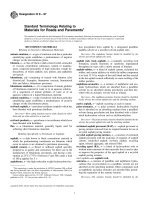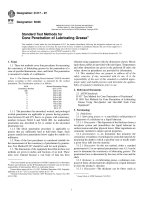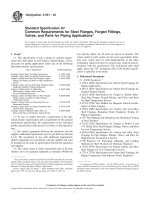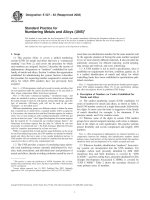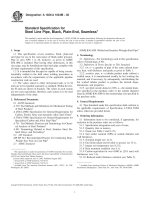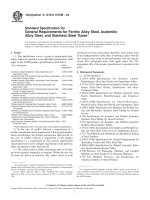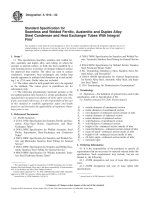Tiêu chuẩn ASTM a530 a530m 03 ;QTUZMC9BNTMWTS1SRUQ
Bạn đang xem bản rút gọn của tài liệu. Xem và tải ngay bản đầy đủ của tài liệu tại đây (49.97 KB, 11 trang )
This document is not an ASTM standard and is intended only to provide the user of an ASTM standard an indication of what changes have been made to the previous version. Because
it may not be technically possible to adequately depict all changes accurately, ASTM recommends that users consult prior editions as appropriate. In all cases only the current version
of the standard as published by ASTM is to be considered the official document.
Designation: A 530/A 530M – 034
Standard Specification for
General Requirements for Specialized Carbon and Alloy
Steel Pipe1
This standard is issued under the fixed designation A 530/A 530M; the number immediately following the designation indicates the year
of original adoption or, in the case of revision, the year of last revision. A number in parentheses indicates the year of last reapproval.
A superscript epsilon (e) indicates an editorial change since the last revision or reapproval.
This standard has been approved for use by agencies of the Department of Defense.
1
This specification is under the jurisdiction of ASTM Committee A01 on Steel, Stainless Steel and Related Alloys and is the direct responsibility of Subcommittee A01.09
on Carbon Steel Tubular Products.
Current edition approved Sept. 10, 2003. March 1, 2004. Published October 2003. March 2004. Originally approved in 1965. Last previous edition approved in 20023
as A 530/A 530M – 023.
Copyright © ASTM International, 100 Barr Harbor Drive, PO Box C700, West Conshohocken, PA 19428-2959, United States.
1
A 530/A 530M – 034
1. Scope*
1.1 This specification2 covers a group of requirements which, with the exceptions of Section 5.3, Section 13, Section 20, and
Section 21, are mandatory requirements to the ASTM pipe product specifications noted below unless the product specification
specifies different requirements, in which case the requirement of the product specification shall prevail.
1.2 Sections 5.3 or 20 are mandatory if the product specification has a requirement for product analysis or flattening tests.
1.3 Section 21 is mandatory if the product specification has a hydrostatic test requirement without defining the test parameters.
1.4 Section 13 is for information only.
1.5 In case of conflict between a requirement of the product specification and a requirement of this general requirement
specification, only the requirement of the product specification need be satisfied.
ASTM DesignationA
Title of Specification
Seamless Carbon Steel Pipe for High-Temperature
Service
Metal-Arc-Welded Steel Pipe for Use With HighPressure Transmission Systems
Centrifugally Cast Ferritic Alloy Steel Pipe for HighTemperature Service
Centrifugally Cast Austenitic Steel Pipe for HighTemperature Service
Seamless Carbon Steel Pipe for Atmospheric and
Lower Temperatures
Centrifugally Cast Iron-Chromium-Nickel High-Alloy
Tubing for Pressure Application at High
Temperatures
Centrifugally Cast Carbon Steel Pipe for HighTemperature Service
Electric-Fusion-Welded Steel Pipe for Atmospheric
and Lower Temperatures
Electric-Fusion-Welded Steel Pipe for High-Pressure
Service at Moderate Temperatures
Carbon and Alloy Steel Pipe, Electric-Fusion-Welded
for High-Pressure Service at High Temperatures
Centrifugally Cast Ferritic/Austenitic Stainless Steel
Pipe for Corrosive Environments
A
A 106
A 381
A 426
A 451
A 524
A 608
A 660
A 671
A 672
A 691
A 872
These designations refer to the latest issue of the respective specifications.
1.6 The values stated in either inch-pound units or SI units are to be regarded separately as standard. Within the text, the SI units
are shown in brackets. The values stated in each system are not exact equivalents; therefore, each system must be used
independently of the other. Combining values from the two systems may result in nonconformance with the specification. The
inch-pound units shall apply unless the “M” designation (SI) of the product specification is specified in the order.
NOTE 1—The dimensionless designator NPS (nominal pipe size) has been substituted in this standard for such traditional terms as “nominal diameter,”
“size,” and “nominal size.”
2. Referenced Documents
2.1 ASTM Standards: 3
A 370 Test Methods and Definitions for Mechanical Testing of Steel Products
A 450/A 450M Specification for General Requirements for Carbon, Ferritic Alloy, and Austenitic Alloy Steel Tubes
A 700 Practices for Packaging, Marking, and Loading Methods for Steel Products for Domestic Shipment
A 751 Test Methods, Practices, and Terminology for Chemical Analysis of Steel Products
A 941 Terminology Relating to Steel, Stainless Steel, Related Alloys, and Ferroalloys
D 3951 Practice for Commercial Packaging
E 29 Practice for Using Significant Digits in Test Data to Determine Conformance with Specifications
2.2 ANSI Standards:
B 36.10 Welded and Seamless Wrought Steel Pipe4
B 36.194 Stainless Steel Pipe
2.3 Military Standards:
MIL-STD-163 Steel Mill Products Preparation for Shipment and Storage5
MIL-STD-271 Nondestructive Testing Requirements for Metals5
MIL-STD-792 Identification Marking Requirements for Special Purpose Components5
2
For ASME Boiler and Pressure Vessel Code applications see related Specification SA-530 in Section II of that Code.
For referenced ASTM standards, visit the ASTM website, www.astm.org, or contact ASTM Customer Service at For Annual Book of ASTM Standards
volume information, refer to the standard’s Document Summary page on the ASTM website.
4
Available from American National Standards Institute, 11 West 42nd St., 13th Floor, New York, NY 10036.
5
Available from Standardization Documents Order Desk, Bldg. 4 Section D, 700 Robbins Ave., Philadelphia, PA 19111-5094, Attn: NPODS.
3
2
A 530/A 530M – 034
2.4 Federal Standards:
Fed. Std. No. 183 Continuous Identification Marking of Iron and Steel Products5
2.5 Steel Structures Painting Council:
SSPC-SP 6 Surface Preparation Specification No. 6 Commercial Blast Cleaning6
3. Terminology
3.1 Definitions of Terms Specific to This Standard:
3.1.1 remelted heat, n—in secondary melting, all of the ingots remelted from a single primary heat.
3.1.2 jointer, n—a length of pipe created by welding two or more shorter lengths of pipe, end-to-end.
3.1.3 thin-wall pipe, n—a pipe having a wall thickness of 3 % or less of the outside diameter.
3.2 Other defined terms—The definitions in Test Methods and Definitions A 370, Test Methods, Practices, and Terminology
A 751, and Terminology A 941 are applicable to this specification and to those listed in 1.5.
4. Process
4.1 The steel shall be made from any process.
4.2 If a specific type of melting is required by the purchaser, it shall be stated on the purchase order.
4.3 The primary melting may incorporate separate degassing or refining and may be followed by secondary melting, using
electroslag remelting or vacuum remelting.
4.4 Steel may be cast in ingots or may be strand cast. When steel of different grades is sequentially strand cast, identification
of the resultant transition material is required. The producer shall remove the transition material by an established procedure that
positively separates the grades.
5. Chemical Composition
5.1 Chemical Analysis—Samples for chemical analysis and method of analysis shall be in accordance with Test Methods,
Practices, and Terminology A 751.
5.2 Heat Analysis—An analysis of each—If the heat of steel shall be made analysis reported by the steel manufacturer to
determine producer is not sufficiently complete for conformance with the percentages of the elements specified. If secondary
melting processes are employed, the heat analysis shall be obtained from one remelted ingot or requirements of the applicable
product specification to be fully assessed, the manufacturer may complete the assessment of one remelted ingot of each primary
melt. The chemical composition thus determined, or that determined from conformance with such heat analysis requirements by
using a product analysis for the specified elements thadt were not reported by the tubular steel producer, provided that product
manufacturer shall conform to analysis tolerances are not applied and the requirements specified. heat analysis is not altered.
5.2.1 For stainless steels ordered under product specifications referencing this specification of general requirements, the steel
shall not contain an unspecified element, other than nitrogen, for the ordered grade to the extent that the steel conforms to the
requirements of another grade for which that element is a specified element having a required minimum content. For this
requirement, a grade is defined as an alloy described individually and identified by its own UNS designation in a table of chemical
requirements within any specification listed within the scope as being covered by this specification.
5.3 Product Analysis—Product analysis requirements and options, if any, are contained in the product specification.
6. Mechanical Requirements
6.1 Method of Mechanical Tests—The specimens and the mechanical tests required shall be in accordance with Test Methods
and Definitions A 370, especially Annex A2 thereof.
6.2 Specimens shall be tested at room temperature.
6.3 Small or subsize specimens as described in Test Methods and Definitions A 370 may be used only when there is insufficient
material to prepare one of the standard specimens. When using small or subsize specimens, the largest one possible shall be used.
7. Tensile Requirements
7.1 The material shall conform to the requirements as to tensile properties prescribed in the individual specifications.
7.2 The yield strength corresponding to a permanent offset of 0.2 % of the gage length or to a total extension of 0.5 % of the
gage length under load shall be determined.
7.3 If the percentage of elongation of any test specimen is less than that specified and any part of the fracture is more than 3⁄4
in. [19.0 mm] from the center of the gage length, as indicated by scribe marks on the specimen before testing, a retest shall be
allowed.
8. Permissible Variation in Weight
8.1 The weight of any length of pipe NPS 12 and under shall not vary more than 10 % over or 3.5 % under that specified. For
sizes over NPS 12, the weight of any length of pipe shall not vary more than 10 % over or 5 % under that specified. Unless
6
Available from Steel Structures Painting Council, 4400 Fifth Ave., Pittsburgh, PA 15213.
3
A 530/A 530M – 034
otherwise specified, pipe of NPS 4 and smaller may be weighed in convenient lots; pipe in sizes larger than NPS 4 shall be weighed
separately.
9. Permissible Variations in Wall Thickness
9.1 Seamless and Welded (no filler metal added)—The minimum wall thickness at any point shall be within the tolerances
specified in Table 1 , except that for welded pipe the weld area shall not be limited by the over tolerance. The minimum wall
thickness on inspection for – 12.5 % is shown in Table X1.1.
9.2 Forged and Bored—The wall thickness shall not vary over that specified by more than 1⁄8 in. [3.2 mm]. There shall be no
variation under the specified wall thickness.
9.3 Cast—The wall thickness shall not vary over that specified by more than 1⁄16 in. [1.6 mm]. There shall be no variation under
the specified wall thickness.
10. Permissible Variations in Inside Diameter
10.1 Forged and Bored, and Cast—The inside diameter shall not vary under that specified by more than 1⁄16 in. [1.6 mm]. There
shall be no variation over the specified inside diameter.
11. Permissible Variations in Outside Diameter
11.1 Variations in outside diameter, unless otherwise specified, shall not exceed the limits prescribed in Table 2. The tolerances
on outside diameter include ovality except as provided for in 11.2 and 11.2.1.
11.2 Thin-wall pipe usually develops significant ovality (out-of-roundness) during final annealing, straightening, or both.
11.2.1 The diameter tolerances of Table 2 are not sufficient to provide for additional ovality expected in thin-wall pipe and are
applicable only to the mean of the extreme (maximum and minimum) outside diameter readings in any one cross-section. However,
for thin-wall pipe the difference in extreme outside diameter readings (ovality) in any one cross-section shall not exceed 1.5 % of
the specified outside diameter.
12. Permissible Variations in Length
12.1 Seamless and Welded (no filler metal added)—If definite cut lengths are ordered, no length of pipe shall be under the length
specified and not more than 1⁄4 in. [6 mm] over that specified.
12.2 Forged and Bored, Cast, and Cast Cold-Wrought —If definite cut lengths are ordered, no length of pipe shall be under the
length specified and not more than 1⁄8 in. [3 mm] over that specified.
12.3 For pipe ordered to random lengths, the lengths and variations shall be agreed upon between the manufacturer and
purchaser.
12.4 No jointers are permitted unless otherwise agreed upon.
13. Standard Weight
13.1 A system of standard pipe sizes has been approved by the American National Standards Institute as ANSI B 36.10 and
B 36.19. These standard sizes do not prohibit the production and use of other sizes of pipe produced to the various specifications
referenced to this Specification.
13.2 For nonstandard sizes of pipe, the calculated weight per foot, shall be determined from the following equation:
W 5 C~D 2 t!t
(1)
TABLE 1 Permissible Variations in Wall Thickness
NPS Designator
Tolerance, % from
Nominal
1⁄8 to 21⁄2 , incl., all t /DA,B ratios
3 to 18 incl., t /Dup to 5 % incl.
3 to 18 incl., t /D> 5 %
20 and larger, welded, all t /D ratios
20 and larger, seamless, t /D up to
5 % incl.
20 and larger, seamless, t /D > 5 %
A
B
t = Nominal wall thickness.
D = Ordered outside diameter.
4
Over
Under
20.0
22.5
15.0
17.5
22.5
12.5
12.5
12.5
12.5
12.5
15.0
12.5
A 530/A 530M – 034
TABLE 2 Permissible Variations in Outside Diameter
NPS Designator
Permissible Variations In Outside Diameter
Over
⁄ to 11⁄2 , incl
Over 11⁄2 to 4, incl
Over 4 to 8, incl
Over 8 to 18, incl
Over 18 to 26, incl
Over 26 to 34, incl
Over 34
18
⁄
1⁄32
1⁄16
3⁄32
1⁄8
5⁄32
3⁄16
1 64
Under
in.
mm
(0.015)
(0.031)
(0.062)
(0.093)
(0.125)
(0.156)
(0.187)
0.4
0.8
1.6
2.4
3.2
4.0
4.8
⁄
1⁄32
1⁄32
1⁄32
1⁄32
1⁄32
1⁄32
1 32
in.
mm
(0.031)
(0.031)
(0.031)
(0.031)
(0.031)
(0.031)
(0.031)
0.8
0.8
0.8
0.8
0.8
0.8
0.8
where:
C = 10.69 [0.0246615],
W = weight, lb/ft [kg/m],
D = specified or calculated (from specified inside diameter and wall thickness) outside diameter, in. [mm], and
t = specified wall thickness, in. (to 3 decimal places) [mm to 2 decimal places].
NOTE 2—The weights given in the American National Standards and the calculated weights given by Eq 1 are based on the weights for carbon steel
pipe. The weight of pipe made of ferritic stainless steels may be about 5 % less, and that made of austenitic stainless steel about 2 % greater than the
values given.
14. Ends
14.1 Unless otherwise specified, the pipe shall be furnished with plain ends. All burrs at the ends of the pipe shall be removed.
15. Straightness
15.1 The finished pipe shall be reasonably straight.
15.2 For metal-arc welded pipe, the maximum deviation from a 10-ft [3.0-m] straightedge placed so that both ends are in contact
with the pipe shall be 1⁄8 in. [3.2 mm]. For metal-arc welded pipe with lengths shorter than 10 ft [3.0 m], this maximum deviation
shall be pro-rated with respect to the ratio of the actual length to 10 ft [3.0 m].
16. Repair by Welding
16.1 Repair by welding of defects in seamless pipe (including centrifugally cast and forged and bored) and of plate defects in
welded pipe and, when specifically stated by the product specification weld seam defects in welded pipe, shall be permitted subject
to the approval of the purchaser and with the further understanding that the composition of the deposited filler metal shall be
suitable for the composition being welded. Defects shall be thoroughly chipped or ground out before welding and each repaired
length shall be reheat treated or stress relieved as required by the applicable specification. Each length of repaired pipe shall be
tested hydrostatically as required by the product specification.
16.2 Repair welding shall be performed using procedures and welders or welding operators that have been qualified in
accordance with the ASME Boiler and Pressure Vessel Code, Section IX.
17. Retests
17.1 If the results of the mechanical tests of any group or lot do not conform to the requirements specified in the individual
specification, retests may be made on additional lengths of pipe of double the original number from the same group or lot, each
of which shall conform to the requirements specified. Only one retest of any group or lot will be permitted. Nonconformance will
be cause for the rejection of the group or lot.
17.2 Any individual length of pipe that meets the test requirements is acceptable. Individual lengths that do not conform to the
test requirements may be resubmitted for test provided the reason for nonconformance is established and the nonconforming
portion removed.
18. Retreatment
18.1 If individual lengths of pipe selected to represent any group or lot fail to conform to the test requirements, the group or
lot represented may be reheat treated and resubmitted for test. The manufacturer may reheat treat the pipe, but not more than twice,
except with the approval of the purchaser on the basis of satisfactory metallurgical evidence that the cause of failure of the test
is curable and the quality of the material is satisfactory.
19. Test Specimens
19.1 Test specimens shall be taken from the ends of finished pipe prior to any forming operations, or being cut to length. They
shall be smooth on the ends and free from burrs and flaws, except for specimens for the flattening test when made from crop ends.
19.2 Specimens cut either longitudinally or transversely shall be acceptable for the tension test.
5
A 530/A 530M – 034
19.3 If any test specimen shows flaws or defective machining, the specimen may be discarded and another substituted.
20. Flattening Test Requirements
20.1 Seamless and Centrifugally Cast Pipe—A section of pipe not less than 21⁄2 in. [63 mm] in length shall be flattened cold
between parallel plates in two steps. During the first step, which is a test for ductility, no cracks or breaks on the inside, outside,
or end surfaces, except as provided for in 20.3.4, shall occur until the distance between the plates is less than the value of H
calculated as follows:
H 5 ~1 1 e!t/~e1t/D!
(2)
where:
H = distance between flattening plates, in. [mm],
t = specified wall thickness, in. [mm],
D = specified or calculated (from the specified inside diameter and wall thickness) outside diameter, in. [mm], and
e = deformation per unit length (constant for a given grade of steel; 0.07 for medium carbon steel (maximum specified carbon
0.19 % or greater), 0.08 for ferritic alloy steel, 0.09 for austenitic steel, and 0.09 for low-carbon steel (maximum specified
carbon 0.18 % or less)).
During the second step, which is a test for soundness, the flattening shall be continued until the specimen breaks or the opposite
walls of the pipe meet.
20.2 Welded Pipe—A section of welded pipe not less than 4 in. [100 mm] in length shall be flattened cold between parallel plates
in two steps. The weld shall be placed 90° from the direction of the applied force (at the point of maximum bending). During the
first step, which is a test for ductility, no cracks or breaks on the inside or outside surfaces, except as provided for in 20.3.4, shall
occur until the distance between the plates is less than the value of H calculated by Eq 2. During the second step, which is a test
for soundness, the flattening shall be continued until the specimen breaks or the opposite walls of the pipe meet.
20.3 Seamless, Centrifugally Cast, and Welded Pipe:
20.3.1 Evidence of laminated or defective material or weld that is revealed during the entire flattening test shall be cause for
rejection.
20.3.2 Surface imperfections not evident in the test specimen before flattening, but revealed during the first step of the flattening
test, shall be judged in accordance with the finish requirements.
20.3.3 Superficial ruptures resulting from surface imperfections shall not be a cause for rejection.
20.3.4 When low D-to- t ratio tubular products are tested, because the strain imposed due to geometry is unreasonably high on
the inside surface at the six and twelve o’clock locations, cracks at these locations shall not be cause for rejection if the D to t ratio
is less than 10.
21. Hydrostatic Test Requirements
21.1 Except as provided in 21.2 and 21.3, each length of pipe shall be tested by the manufacturer to a hydrostatic pressure which
will produce in the pipe wall a stress not less that 60 % of the minimum specified yield strength for carbon and ferritic alloy steel
pipe, or 50 % of the specified minimum yield strength for austenitic alloy steel pipe. The test pressure or stress shall be determined
by the following equation:
P 5 2St/D or S 5 PD/2t
(3)
where:
P = hydrostatic test pressure in psi or MPa,
S = pipe wall stress in psi or MPa,
t = specified nominal wall thickness, nominal wall thickness corresponding to specified ANSI schedule number, or 1.143 times
the specified minimal wall thickness, in. [mm], and
D = specified outside diameter, outside diameter corresponding to specified ANSI pipe size, or outside diameter calculated by
adding 2t (as defined above) to the specified inside diameter, in. [mm].
21.1.1 The hydrostatic test pressure determined by the equation shall be rounded to the nearest 50 psi [0.5 MPa] for pressures
below 1000 psi [7 MPa], and to the nearest 100 psi [1 MPa] for pressures 1000 psi [7 MPa] and above. The hydrostatic test may
be performed prior to cutting to final length, or prior to upsetting, swaging, expanding, bending, or other forming operations.
21.2 Regardless of pipe-wall stress-level determined by Eq 3, the minimum hydrostatic test pressure required to satisfy these
requirements need not exceed 2500 psi [17.0 MPa] for outside diameters (see D in 21.1) of 3.5 in. [88.9 mm] or less, nor 2800
psi [19.0 MPa] for outside diameters over 3.5 in. [88.9 mm]. This does not prohibit testing at higher pressures at the manufacturer’s
option or as provided in 21.3.
21.3 With concurrence of the manufacturer, a minimum hydrostatic test pressure in excess of the requirements of 21.2 or 21.1,
or both, may be stated on the order.
21.4 The test pressure shall be held for a minimum of 5 s, without resultant leakage through the pipe wall. For welded pipe,
the test pressure shall be held for a time sufficient to permit the inspector to examine the entire length of the welded seam.
21.5 The hydrostatic test may not be capable of inspecting the end portion of the pipe. The length of pipe that cannot be tested
shall be determined by the manufacturer and, when specified in the purchase order, reported to the purchaser.
6
A 530/A 530M – 034
22. Certified Test Report
22.1 When specified in the purchase order or contract, the producer or supplier shall furnish a Certified Test Report certifying
that the material was manufactured, sampled, tested and inspected in accordance with the Specification, including year date, the
Supplementary Requirements, and any other requirements designated in the purchase order or contract, and that the results met
the requirements of that Specification, the Supplementary Requirements and the other requirements. A signature or notarization is
not required on the Certified Test Report, but the document shall be dated and shall clearly identify the organization submitting
the Report.
NOTE 3—Notwithstanding the absence of a signature or notarization, the organization submitting the Report is responsible for the contents of the
Report.
22.2 In addition, the Certified Test Report shall include the following information and test results, when applicable:
22.2.1 Heat Number,
22.2.2 Heat Analysis,
22.2.3 Product Analysis, if specified or required,
22.2.4 Tensile Properties,
22.2.5 Width of the gage length, when longitudinal strip tension test specimens are used,
22.2.6 Bend Test acceptable,
22.2.7 Flattening Test acceptable,
22.2.8 Hydrostatic Test pressure
22.2.9 Non-destructive Electric Test method,
22.2.10 Impact Test results, and
22.2.11 Other test results or information required to be reported by the product specification.
22.3 Test results or information required to be reported by supplementary requirements, or other requirements designated in the
purchase order or contract shall be reported, but may be reported in a separate document.
22.4 The Certified Test Report shall include a statement of explanation for the letter added to the specification number marked
on the tubes (see 25.5) when all of the requirements of the specification have not been completed. The purchaser must certify that
all requirements of the specification have been completed before removal of the letter (that is, X, Y, or Z).
22.5 When certification is required for material that has not been hydrostatically tested, the Certificate of Test shall state “Not
hydrostatically tested’’, and the letters “NH’’ shall be appended to the product specification number, material grade and class
shown on the Certificate.
23. Inspection
23.1 The inspector representing the purchaser shall have entry at all times while work on the contract of the purchaser is being
performed, to all parts of the manufacturer’s works that concern the manufacture of the material ordered. The manufacturer shall
afford the inspector all reasonable facilities to satisfy him that the material is being furnished in accordance with this specification.
All required tests and inspection shall be made at the place of manufacture prior to shipment, unless otherwise specified, and shall
be conducted so as not to interfere unnecessarily with operation of the works.
24. Rejection
24.1 Each length of pipe received from the manufacturer may be inspected by the purchaser and, if it does not meet the
requirements of the specification based on the inspection and test method as outlined in the specification, the length may be rejected
and the manufacturer shall be notified. Disposition of rejected pipe shall be a matter of agreement between the manufacturer and
the purchaser.
24.2 Pipe that fails in any of the forming operations or in the process of installation and is found to be defective shall be set
aside and the manufacturer shall be notified for mutual evaluation of the suitability of the pipe. Disposition of such pipe shall be
a matter for agreement.
25. Product Marking
25.1 Each length of pipe shall be legibly marked with the manufacturer’s name or brand, the specification number (year of issue
not required) and grade. Marking shall begin approximately 12 in. [300 mm] from the end of each length of pipe. For pipe less
than NPS 2 and pipe under 3 ft [1 m] in length, the required information may be marked on a tag securely attached to the bundle
or box in which the pipes are shipped.
25.2 When pipe marked as specified is rejected, the ASTM designation shall be cancelled.
25.3 For austenitic steel pipe, the marking paint or ink shall not contain any harmful metal, or metal salts, such as zinc, lead,
or copper, which cause corrosive attack on heating.
25.4 Pipes which have been weld repaired in accordance with 16.1 shall be marked WR.
25.5 When it is specified that certain requirements of a specification adopted by the ASME Boiler and Pressure Vessel
Committee are to be completed by the purchaser upon receipt of the material, the manufacturer shall indicate that all requirements
of the specification have not been completed by a letter such as X, Y, or Z, immediately following the specification number. This
7
A 530/A 530M – 034
letter may be removed after completion of all requirements in accordance with the specification. An explanation of specification
requirements to be completed is provided in 24.1.
25.6 Bar Coding—In addition to the requirements in 25.1, 25.2, 25.3, 25.4 and 25.5, bar coding is acceptable as a supplemental
identification method. The purchaser may specify in the order a specific bar coding system to be used.
26. Packaging, Marking, and Loading
26.1 When specified on the purchase order, packaging, marking, and loading for shipment shall be in accordance with the
procedures of Practices A 700.
27. Government Procurement
27.1 When specified in the contract or order, the following requirements shall be considered in the inquiry contract or order for
agencies of the U.S. Government where scale free pipe is required. These requirements shall take precedence if there is a conflict
between these requirements and the product specification.
27.1.1 Pipe shall be ordered to nominal pipe size (NPS) and schedule. Nominal pipe shall be as specified in ANSI B 36.10.
27.1.2 Responsibility for Inspection— Unless otherwise specified in the contract or purchase order, the manufacturer is
responsible for the performance of all inspection and test requirements specified. The absence of any inspection requirements in
the specification shall not relieve the contractor of the responsibility for ensuring that all products or supplies submitted to the
Government for acceptance comply with all requirements of the contract. Sampling inspection, as part of the manufacturing
operations, is an acceptable practice to ascertain conformance to requirements, however, this does not authorize submission of
known defective material, either indicated or actual, nor does it commit the Government to accept the material. Except as otherwise
specified in the contract or purchase order, the manufacturer may use his own or any other suitable facilities for the performance
of the inspection and test requirements unless disapproved by the purchaser at the time the order is placed. The purchaser shall
have the right to perform any of the inspections and tests set forth when such inspections and tests are deemed necessary to ensure
that the material conforms to the prescribed requirements.
8
A 530/A 530M – 034
27.1.3 Sampling for Flattening and Flaring Test and for Visual and Dimensional Examination—Minimum sampling for
flattening and flaring tests and visual and dimensional examination shall be as follows:
Lot Size (pieces per lot)
Sample Size
2 to
8
9 to
90
91 to 150
151 to 280
281 to 500
501 to 1200
1201 to 3200
3201 to 10 000
10 001 to 35 000
Entire lot
8
12
19
21
27
35
38
46
In all cases, the acceptance number is zero and the rejection number is one. Rejected lots may be screened and resubmitted for
visual and dimensional examination. All defective items shall be replaced with acceptable items prior to lot acceptance.
27.1.4 Sampling for Chemical Analysis— One sample for chemical analysis shall be selected from each of two pipes chosen
from each lot. A lot shall be all material poured from one heat.
27.1.5 Sampling for Tension and Bend Test— One sample shall be taken from each lot. A lot shall consist of all pipe of the same
outside diameter and wall thickness manufactured during an 8-h shift from the same heat of steel, and heat treated under the same
conditions of temperature and time in a single charge in a batch type furnace, or heat treated under the same condition in a
continuous furnace, and presented for inspection at the same time.
27.1.6 Hydrostatic and Ultrasonic Tests— Each pipe shall be tested by the ultrasonic (when specified) and hydrostatic tests.
27.1.7 Pipe shall be free from heavy oxide or scale. The internal surface of hot finished ferritic steel pipe shall be pickled or
blast cleaned to a free of scale condition equivalent to the CSa2 visual standard listed in SSPC-SP6. Cleaning shall be performed
in accordance with a written procedure that has been shown to be effective. This procedure shall be available for audit.
27.1.8 In addition to the marking in Specification A 450/A 450M, each length of pipe 1⁄4 in. outside diameter and larger shall
be marked with the following listed information. Marking shall be in accordance with FED-STD-183 and MIL-STD-792. (a)
Nominal Pipe Size Schedule and Length (b) Heat or lot identification number.
27.1.9 Pipe shall be straight to within the tolerances specified in Table 3.
27.1.10 When specified, each pipe shall be ultrasonically examined in accordance with MIL-STD-271, except that the notch
depth in the calibration standard shall be 5 % of the wall thickness or 0.005 in., whichever is greater. Any pipe which produces
an indication equal to or greater than 100 % of the indication from the calibration standard shall be rejected.
27.1.11 The pipe shall be free from repair welds, welded joints, laps, laminations, seams, visible cracks, tears, grooves, slivers,
pits, and other imperfections detrimental to the pipe as determined by visual and ultrasonic examination, or alternate tests, as
specified.
27.1.12 Pipe shall be uniform in quality and condition and have a finish conforming to the best practice for standard quality pipe.
Surface imperfections such as handling marks, straightening marks, light mandrel and die marks, shallow pits, and scale pattern
will not be considered injurious if the imperfections are removable within the tolerances specified for wall thickness or 0.005 in.,
whichever is greater. The bottom of imperfections shall be visible and the profile shall be rounded and faired-in.
27.1.13 No weld repair by the manufacturer is permitted.
27.1.14 Preservation shall be level A or commercial, and packing shall be level A, B, or commercial, as specified. Level A
preservation and level A or B packing shall be in accordance with MIL-STD-163 and commercial preservation and packing shall
be in accordance with Practices A 700 or Practice D 3951.
28. Keywords
28.1 alloy steel pipe; carbon steel pipe; general delivery requirements; steel pipe
TABLE 3 Straightness Tolerances
Specified OD, in.
Up to 5.0, incl.
Over 5.0 to 8.0,
incl.
Over 8.0 to
12.75, incl.
Specified wall
thickness, in.
Maximum
curvature in any
3 ft, in.
Maximum
curvature in total
length, in.
Over 3 % OD to
0.5, incl.
Over 4 % OD to
0.75, incl.
Over 4 % OD to
1.0, incl.
0.030
0.010 3 length, ft
0.045
0.015 3 length, ft
0.060
0.020 3 length, ft
9
A 530/A 530M – 034
APPENDIX
(Nonmandatory Information)
X1. TABLE OF MINIMUM WALL THICKNESSES
Table X1.1 displays minimum wall thicknesses.
TABLE X1.1 Minimum Wall Thicknesses on Inspection for Nominal (Average) Pipe Wall Thicknesses
NOTE 1—The following equation, upon which this table is based, may be applied to calculate minimum wall thickness from nominal (average) wall
thickness:
tn3 0.875 = tm
where:
tn = nominal (average) wall thickness, in. [mm], and
tm = minimum wall thickness, in. [mm].
The wall thickness is expressed to three decimal places, the fourth decimal place being carried forward or dropped, in accordance with the Practice E 29.
NOTE 2—This table is a master table covering wall thicknesses available in the purchase of different classifications of pipe, but it is not meant to imply
that all of the walls listed therein are obtainable under this specification.
Nominal (Average)
Thickness
(tn)
in.
0.068
0.088
0.091
0.095
0.113
0.119
0.125
0.126
0.133
0.140
0.145
0.147
0.154
0.156
0.179
0.187
0.188
0.191
0.200
0.203
0.216
0.218
0.219
0.226
0.237
0.250
0.258
0.276
0.277
0.279
0.280
0.281
A
Minimum Thickness
on Inspection
(tm)
Nominal (Average)
Thickness
(tn)
Minimum Thickness
on Inspection
(tm)
Nominal (Average)
Thickness
(tn)
Minimum Thickness
on Inspection
(tm)
mm
in.
mm
in.
mm
in.
mm
in.
mm
in.
mm
1.73
2.24
2.31
2.41
2.87
3.02
3.18
3.20
3.38
3.56
3.68
3.73
3.91
3.96
4.55
4.75
4.78
4.85
5.08
5.16
5.49
5.54
5.56
5.74
6.03
6.35
6.55
7.01
7.04
7.09
7.11
7.14
0.060
0.077
0.080
0.083
0.099
0.104
0.109
0.110
0.116
0.122
0.127
0.129
0.135
0.136
0.157
0.164
0.164
0.167
0.175
0.178
0.189
0.191
0.192
0.198
0.207
0.219
0.226
0.242
0.242
0.244
0.245
0.246
1.52
1.96
2.03
2.11
2.51
2.64
2.77
2.79
2.95
3.10
3.23
3.28
3.43
3.45
3.99
4.17
4.17
4.24
4.44
4.52
4.80
4.85
4.88
5.03
5.23
5.56
5.74
6.15
6.15
6.20
6.22
6.25
0.294
0.300
0.307
0.308
0.312
0.318
0.322
0.330
0.337
0.343
0.344
0.358
0.365
0.375
0.382
0.400
0.406
0.432
0.436
0.437
0.438
0.500
0.531
0.552
0.562
0.593
0.600
0.625
0.656
0.674
0.687
0.719
7.47
7.62
7.80
7.82
7.92
8.08
8.18
8.38
8.56
8.71
8.74
9.09
9.27
9.52
9.70
10.16
10.31
10.97
11.07
11.10
11.13
12.70
13.49
14.02
14.27
15.06
15.24
15.88
16.62
17.12
17.45
18.26
0.257
0.262
0.269
0.270
0.273
0.278
0.282
0.289
0.295
0.300
0.301
0.313
0.319
0.328
0.334
0.350
0.355
0.378
0.382
0.382
0.383
0.438
0.465
0.483
0.492
0.519
0.525
0.547
0.573
0.590
0.601
0.629
6.53
6.65
6.83
6.86
6.93
7.06
7.17
7.34
7.49
7.62
7.65
7.95
8.10
8.33
8.48
8.89
9.02
9.60
9.70
9.70
9.73
11.13
11.81
12.27
12.50
13.18
13.34
13.89
14.55
14.99
15.27
15.98
0.750
0.812
0.843
0.864
0.875
0.906
0.937
0.968
1.000
1.031
1.062
1.093
1.125
1.156
1.218
1.250
1.281
1.312
1.343
1.375
1.406
1.438
1.500
1.531
1.562
1.593
1.750
1.781
1.812
1.968
2.062
2.343
19.05
20.62
21.41
21.95
22.22
23.01
23.80
24.59
25.40
26.19
26.97
27.76
28.57
29.36
30.94
31.75
32.54
33.32
34.11
34.92
35.71
36.52
38.10
38.89
39.67
40.46
44.45
45.24
46.02
49.99
52.38
59.51
0.656
0.710
0.738
0.756
0.766
0.793
0.820
0.847
0.875
0.902
0.929
0.956
0.984
1.012
1.066
1.094
1.121
1.148
1.175
1.203
1.230
1.258
1.312
1.340
1.367
1.394
1.531
1.558
1.586
1.722A
1.804
2.050
16.62
18.03
18.75
19.20
19.46
20.14
20.83
21.51
22.22
22.91
23.60
24.28
24.99
25.70
27.08
27.77
28.47
29.16
29.84
30.56
31.24
31.95
33.32
34.04
34.72
35.40
38.89
39.57
40.28
43.74
45.82
52.07
Editorially corrected in October 2000.
10
A 530/A 530M – 034
SUMMARY OF CHANGES
Committee A01 has identified the location of selected changes to this specification since the last edition,
A 530/A 530M-02, issue, A 530/A 530M-03, that may impact the use of this standard. specification. (Approved
September 10, 2003) March 1, 2004)
(1) Added reference to Terminology A 941 in Section 2.
( 2) Added a Terminology Section (new Section 3), including a definition for “jointer,” and renumbered the subsequent sections
accordingly. Revised 5.2.
Committee A01 has identified the location of selected changes to this specification since the last edition, A 530/A 530M-99
issue, A 530/A 530M-02, that may impact the use of this standard. specification. (Approved September 10, 20023)
e1
,
(1) Paragraph 1.5 was revised Added reference to delete standards that were either discontinued or now have their general
requirements addressed by Specification A 999/A 999M. Terminology A 941 in Section 2.
( 2) Added a Terminology Section (new Section 3), including a definition for “jointer,” and renumbered the subsequent sections
accordingly.
ASTM International takes no position respecting the validity of any patent rights asserted in connection with any item mentioned
in this standard. Users of this standard are expressly advised that determination of the validity of any such patent rights, and the risk
of infringement of such rights, are entirely their own responsibility.
This standard is subject to revision at any time by the responsible technical committee and must be reviewed every five years and
if not revised, either reapproved or withdrawn. Your comments are invited either for revision of this standard or for additional standards
and should be addressed to ASTM International Headquarters. Your comments will receive careful consideration at a meeting of the
responsible technical committee, which you may attend. If you feel that your comments have not received a fair hearing you should
make your views known to the ASTM Committee on Standards, at the address shown below.
This standard is copyrighted by ASTM International, 100 Barr Harbor Drive, PO Box C700, West Conshohocken, PA 19428-2959,
United States. Individual reprints (single or multiple copies) of this standard may be obtained by contacting ASTM at the above
address or at 610-832-9585 (phone), 610-832-9555 (fax), or (e-mail); or through the ASTM website
(www.astm.org).
11
